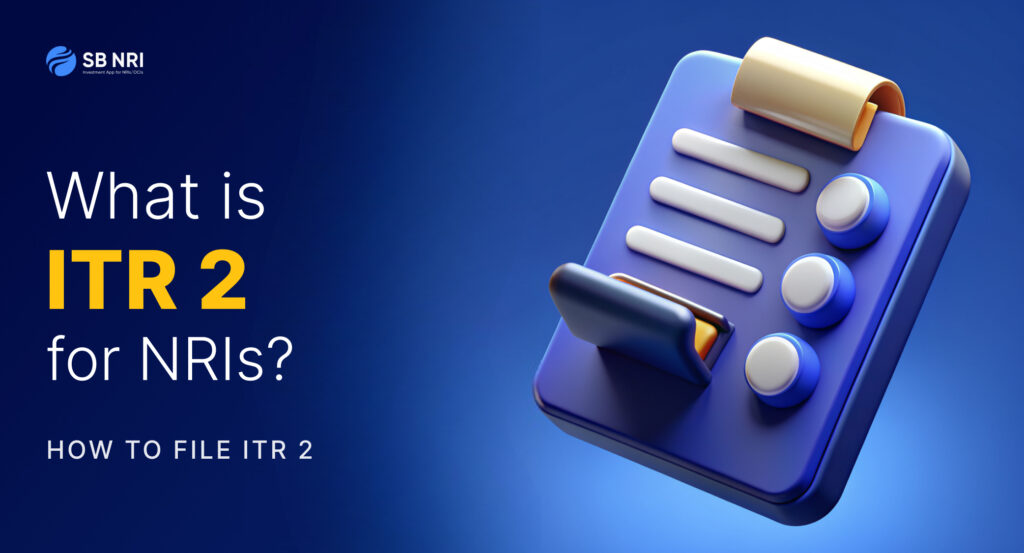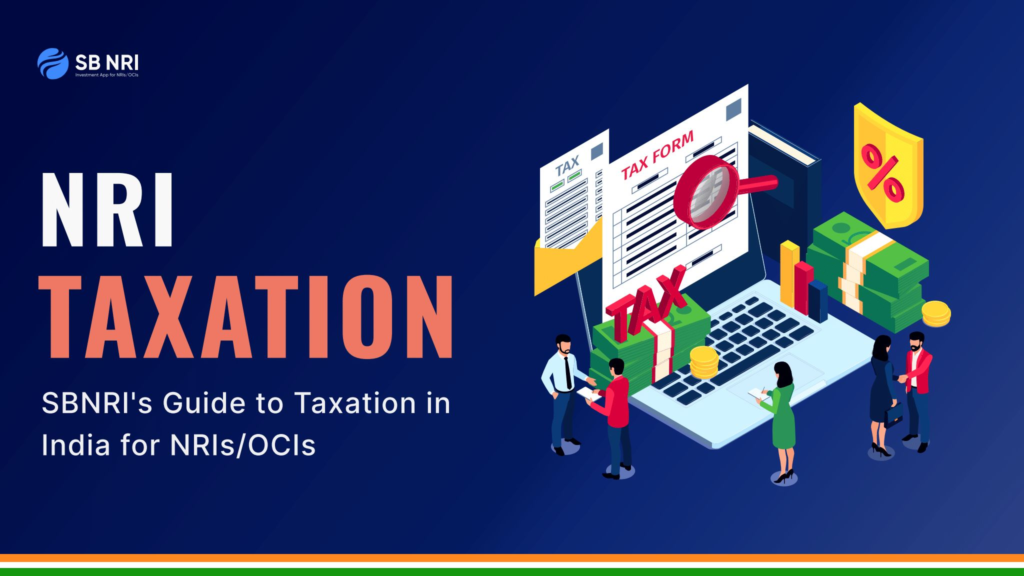
For Non-Resident Indians(NRIs) and Overseas Citizens of India (OCIs), filing income tax return in India can seem like a confusing task due to their residential status change and more. However, understanding the various forms and their purposes can simplify the process significantly. One such form that NRIs often need to be familiar with is the ITR 2. In this blog, we’ll look at ITR 2 for NRIs, its relevance, Income Tax rates under the new regime/old regime, and how to file ITR 2 as NRI/OCI.
What is ITR 2?
ITR-2 is an income tax return form for individuals and Hindu Undivided Families (HUFs) not having income from business or profession. The ITR 2 form is particularly relevant for NRIs as they cannot file ITR 1. It includes income from salary, multiple house properties, capital gains, winnings from lotteries, and foreign income. It covers agricultural income over ₹5000 and income from virtual digital assets like cryptocurrency. This form is also for residents with foreign tax credits, directors of companies, and those with unlisted equity shares. It’s suitable for higher incomes exceeding ₹50 lakh from diverse sources.
Also read: ITR 1 vs ITR 2: Key Difference, Meaning and Who can File It?
Who can file ITR 2?
ITR-2 can be filled by individuals, HUFs, NRIs/OCIs whose total income for the assessment year includes:
- Income from Salary or Pension
- Income from House Property
- Income from short-term or long-term capital gains or sale of investments and property
- Income from Other Sources such as, Winnings from Lottery and Income from Race Horses
- Foreign Assets
- Individuals generating income of Rs.5000 and above from agricultural sources
- Individual who is a director of the company
- An individual invested in unlisted equity shares
Note: The total income generated from the above-mentioned sources can be Rs.50 lakh and above.
Also Read: Income Tax e-filing: Top 10 NRI Income Tax Filing Benefits

Why is ITR 2 Important for NRIs?
For NRIs, the ITR 2 form is crucial for several reasons:
- Multiple Sources of Income: NRIs often have diverse income sources, including income from house property, capital gains, and foreign assets. The ITR-2 is designed to accommodate these varied income streams.
- Foreign Assets and Income: NRIs with foreign assets or income must report these details accurately. The ITR-2 provides a comprehensive section to declare foreign income and assets, ensuring compliance with Indian tax laws.
- Exemptions and Deductions: NRIs can claim various exemptions and deductions under the Indian Income Tax Act. The ITR-2 form allows NRIs to claim deductions under sections 80C to 80U, ensuring they benefit from the available tax reliefs.
Also read: 5 Tips for NRIs Filing Income Tax Returns in India
Steps to File ITR 2 for NRIs
Filing the ITR-2 form involves several steps, mentioned as below:
- Gather Required Documents: Before you start filling out the ITR-2 form, ensure you have all the necessary documents, such as your PAN card, Aadhaar card, bank statements, salary slips, Form 16, and details of your foreign assets and income.
- Download the Form: The ITR 2 form can be downloaded from the official Income Tax Department website. Alternatively, you can use the online e-filing portal to fill out and submit the form electronically.
- Fill in Personal Information: Enter your personal details, including your name, PAN, address, and email ID. Ensure that these details match the records with the Income Tax Department.
- Report Income Details: Accurately report your income from various sources, such as salary, house property, capital gains, and other sources. For NRIs, it is crucial to include details of foreign income and assets.
- Claim Deductions: Claim the deductions you are eligible for under sections 80C to 80U. These deductions can significantly reduce your taxable income.
- Verify Tax Computation: Verify the tax computation based on the income and deductions declared. Ensure that the correct tax rates for NRIs are applied.
- Submit and Verify: Once you have filled out the form, submit it electronically through the e-filing portal. After submission, you need to verify your return. This can be done online using Aadhaar OTP, net banking, or by sending a physical copy of the ITR 2 to the Income Tax Department.
Also read: ITR Filing for NRIs AY 2024-25: Step-by-Step ITR Filing Process
Key Points to Remember while Filing ITR 2 as NRI/OCI
- Residential Status: Ensure you correctly determine your residential status for the financial year, as this impacts the applicability of tax rates and the necessity to report foreign assets.
- Double Taxation Avoidance Agreement (DTAA): If you have income that is taxed in both India and your country of residence, refer to the DTAA to avoid double taxation.
- Due Date: For NRIs, the due date for filing the ITR 2 is usually July 31st of the assessment year. However, keep an eye on announcements from the Income Tax Department for any extensions.
Also read: Getting ITR Notice as NRI/OCI? Here’s what you need to know

NRI Income Tax Slab Rates for AY 2024-25 (FY 2023-24) – New Tax Regime & Old Tax Regime
| Income Tax Slab | Old Regime Slab Rates for FY 23-24 (AY 24-25) |
|---|---|
| Up to Rs. 2.50 lakh | Nil |
| Rs. 2,50,000 -Rs. 5,00,000 | 5% |
| Above Rs. 5 lakh to Rs. 6 lakh | Rs. 12,500 + 20% |
| Above Rs. 6 lakh to Rs. 7.50 lakh | Rs. 12,500 + 20% |
| Rs. 7.50,000 to Rs. 9,00,000 | Rs. 12,500 + 20% |
| Rs. 9,00,000 to Rs. 10,00,000 | Rs. 12,500 + 20% |
| Rs. 10,00,000-Rs. 12,00,000 | Rs. 1,12,500 + 30% |
| Rs. 12,00,000-Rs. 12,50,000 | Rs. 1,12,500 + 30% |
| Rs. 12,50,000-Rs. 15,00,000 | Rs. 1,12,500 + 30% |
| Above Rs. 15,00,000 | Rs. 1,12,500 + 30% |
| Income Tax Slab | New Regime Slab Rates for FY 23-24 (AY 24-25) |
|---|---|
| Up to Rs. 3 lakh | Nil |
| Rs. 3,00,000 -Rs. 6,00,000 | 5% (Rebate u/s 87A available) |
| Rs. 6,00,001 lakh to Rs. 9,00,000 | 10% (Rebate u/s 87A available for taxable income up to 7 lacs) |
| Rs. 9,00,001 to Rs. 12,00,000 | 15% |
| Rs. 12,00,001 to Rs. 15,00,000 | 20% |
| Above Rs 15,00,000 | 30% |
Also read: TDS on Sale of Property by NRI in India [New Rates for 2024]
Calculate your TDS Refund with SBNRI’s TDS Refund Calculator
A TDS refund is the process of reclaiming the excess tax deducted at source by the payer if the actual tax liability of the taxpayer is lower than the TDS deducted. This situation typically arises when the income tax calculated on the total income is less than the TDS already deducted. To claim a TDS refund, taxpayers need to file an income tax return (ITR). The Income Tax Department processes the ITR and verifies the details. If the tax department finds that the TDS paid is more than the actual tax liability, the excess amount is refunded to the taxpayer.
You can easily find out how much tax refund you can get by calculating your TDS Refund from this TDS Refund Calculator.
Access SBNRI’s Exclusive NRI Taxation Guide

NRIs and OCIs can now access SBNRI’s exclusive NRI Taxation Guide covering in-depth information about DTAA, Gift Tax, Rental Income Tax, ITR Filing, Types of ITR Forms for NRIs, Capital Gain Tax, Income Tax, and more. The report will help you understand India taxation on mutual funds, other asset classes and how you can comply with the regulations.
Access NRI Taxation report here
Wrapping Up
Filing the ITR 2 form is crucial for NRIs/OCIs to ensure compliance with Indian tax regulations and to get refunds for tax deducted in the financial year. By understanding what the ITR 2 form is and how to file it, NRIs can navigate the tax filing process with confidence. Always consider consulting a tax professional to address specific queries and ensure accurate filing.
Looking for NRI ITR Filing? Connect with SBNRI NRI Tax Expert CA Today!

At SBNRI, we have simplified ITR filing for NRIs/OCIs through a smooth digital journey. Be it Basic Filing, Advanced Filing (includes Capital Gain, etc.), or Premium Filing (Foreign Income), we can help you assess the right computation and lower your tax liability.
“We’ve helped over 500+ NRIs/OCIs file ITR returns and more than 25,000+ across other taxation services last financial year and we’d love to help you out too”
You can download SBNRI App or connect with NRI Tax Expert team directly via the button below.
FAQ
What happens if I fill ITR 1 instead of ITR 2?
If you choose a wrong ITR form, the filed return will be treated as defective and you will need to file a revised ITR using the correct form.
Who is eligible for ITR-1?
ITR 1 Form can be filed by:
- Taxpayers.
- Individuals who are a Resident with a total Income of up to INR 50 lakhs when the Income is from Salaries.
- One House Property
- Other Sources; Interest, dividend, etc.
- Agricultural Income up to INR 5 thousand.
Who are not eligible to fill ITR-2:
- Any individual or HUF having income from business or profession
- Individuals who are eligible to fill out the ITR-1 form (Sahaj)
Can a salaried person file ITR 1?
ITR-1 may be filed by someone who earns money from a job, a home, or other outlets. NRIs are not eligible to file an ITR-1.
Can a non-resident India file the ITR 2 form?
Yes, NRI non-resident Indians are eligible to file for ITR 2 form.
What are the documents that one requires to file an ITR 2 form?
Documents required to fill ITR 2 form are mentioned as follows :
- TDS certificates.
- Bank statements.
- Last year’s tax return copy.
- Savings certificates, etc.
Is it possible to file ITR 2 online?
Yes, an individual can file their ITR-2 online.
When is the last date to file an income tax return in India for NRIs?
NRIs need to file income tax returns in India before 31st July without any penalty, unless the government extends the last date.
What is the rule for NRI in ITR?
If the annual returns for NRIs cross the basic exemption limit of Rs 2.5 lakh, NRIs should file their return. However, there are cases where the NRIs/OCIs need to file their return even if their income is less than Rs 2.5 lakh. Here are those cases:
- If you have deposits or aggregate of more than 1 cr in one or more current accounts
- If you spend more than 2 lacs on foreign travel
- If you spend more than 1 lacs on electricity expenditure
Should NRIs file tax returns in India?
NRIs should file income tax returns in India if they earned income in India during the financial year. Their tax liability depends on their residential status.
Do NRIs need to be present in India to file an ITR?
No, it is not true. NRIs can easily file and validate their income tax returns online from anywhere in the world.
What is the income tax rate for NRIs?
NRI income tax rates are mentioned in the first table in this blog along with the NRI income tax slabs.
When should an NRI file an income tax return in India?
Like resident taxpayers, an NRI must file his/her return of income in India if his/ her Indian income exceeds Rs. 2.5 lakh for the financial year. The last date for income tax filing for NRIs is 31st July of the assessment year.
Is new tax regime applicable to NRIs?
Yes new tax regime is applicable to NRIs. The new tax regime allows the basic exemption to Rs. 3,00,000. However, NRIs can’t claim the rebate on full tax for income up to Rs. 7 lakh.
What is the 80C limit for 2023-24 for NRIs?
Section 80C enables NRIs to lower their taxable income by a maximum deduction of ₹ 1.5 lakh. This deduction can be achieved by making tax-saving investments, such as paying life insurance premiums, expenses like school tuition fees. However, if NRI taxpayers choose the new tax regime, they are not permitted to claim this deduction.



